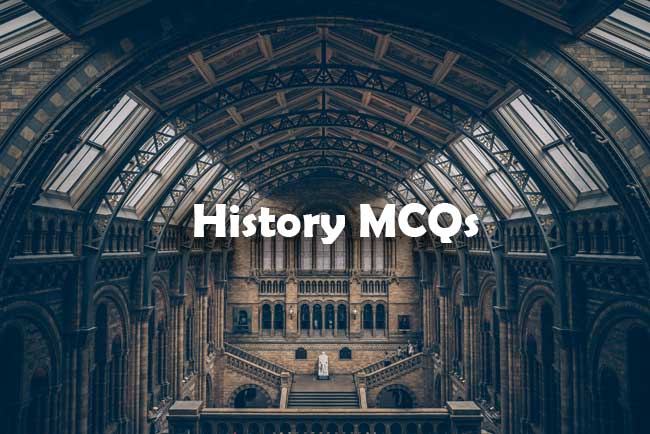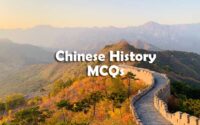AFCAT History Questions
Find the direct download link for AFCAT History Questions paper pdf in the section below. Aspirants who are looking for AFCAT History General Knowledge Papers can find in the table below. Are you searching for the Air Force Common Admission Test History Sample Papers for starting exam preparation?

Don’t worry. We attached the free downloading links of Air Force Common Admission Test History General Knowledge Old Papers. By referring the Last 5 years Air Force Common Admission Test History Previous Question Papers, candidates can analyse the exam pattern.
AFCAT History Questions Papers will help you to get a good score in the exam. By clicking on the below-enclosed links, you can download the AFCAT History Questions Papers with solutions in the form of Pdf.
History Questions for AFCAT Exam
1. The first Sanskrit text based on the Buddha’s life is :
(A) Gatha Saptashati
(B) Karpurmanjiri
(C) Buddhacharitam
(D) Amarkosha
2. Which one of the following rules were not fixed by the guilds ?
(A) Work
(B) Price
(C) Distribution
(D) Social Conduct
3. Which of the following urban centres was not prominent during Satavahan times ?
(A) Pratishthan
(B) Ujjain
(C) Arikamedu
(D) Kanchivaram
4. The idea of incarnation associated with the protection of the society, became widespread during :
(A) Post-Gupta period
(B) Post-Mauryan period
(C) Post-Harshavardhana period
(D) Rigvedic period
5. Which of the following was not a capital of a regional kingdom in the early Medieval Period ?
(A) Malkhed
(B) Kanchipuram
(C) Aihole
(D) Badami
6. An important early medieval description of the west-coast of India is found in the writings of :
(A) Al-Idrisi
(B) Al-Masudi
(C) Ibn-Batutah
(D) Abdur Razzaq
7. In the course of the 11th century, the intercourse between South India and China had become so wide spread that a large Chinese settlement came up Tamil Nadu at the port of :
(A) Kaveripatnam
(B) Mailapur
(C) Cuddalore
(D) Nagapattnam
8. Mount Abu temples were built between the :
(A) 12th and 14th centuries
(B) 11th and 13th centuries
(C) 10th and 12th centuries
(D) 9th and 11th centuries
9. Which of the following gives the correct order of Medieval ports, from North to South ?
(A) Sopara, Kalyan, Thane, Panvel
(B) Thane, Kalyan, Sopara, Panvel
(C) Panvel, Thane, Sopara, Kalyan
(D) Kalyan, Panvel, Thane, Sopara
10. An important medieval merchant guild of South India was the :
(A) Shreni
(B) Samaya
(C) Nagarattar
(D) Ayyavole
11. Which of the following pairs is not correctly matched ?
(A) Amir Khusrau : Tughlaqnama
(B) Afif : Tarikh-i-Firozshahi
(C) Barni : Futuh-us-Salatin
(D) Yadhya bin Ahmad Sirhindi : Tarikh-i-Mubarak Shahi
12. A crucial factor in the decline of the Bahmani rule was :
(A) The rise of regionally powerful nobles
(B) The arrival of the Portuguese on the Indian coast
(C) The rise of the Vijayanagar Empire
(D) The long-drawn-out conflict between the Afaqis and Deccanis
13. The Aravidu dynasty was the :
(A) Fourth Dynasty of Vijayanagar
(B) Third Dynasty of Vijayanagar
(C) Second Dynasty of Vijayanagar
(D) First Dynasty of Vijayanagar
14. From whom, in all probability, did the Marathas secure training in the art of Guerilla warfare ?
(A) Sambhaji
(B) Shivaji
(C) Shahji
(D) Malik Ambar
15. What term is used to describe the amount taken as war booty by the Pindaris when they travelled with the Maratha armies ? What percentage was claimed by them ?
(A) Katraparcha, 15%
(B) Zortalab, 45%
(C) Maganmai, 10%
(D) Palpatti, 25%
16. What was the unit of measurement of land in the Maratha dominions ?
(A) Jarib
(B) Taraf
(C) Kathi
(D) Daftari Bigha
17. The word Medhekat means :
(A) A wooden fort
(B) A fort with stone bastions
(C) A hill fort
(D) A sea facing fort
18. Mashrut means a rank attached to :
(A) A place
(B) A person
(C) A village
(D) A province
19. The Patrimonial Bureaucratic model of the Mughal state put forward by Stephen Blake is based on :
(A) The theories of Talcott Parsons
(B) The theories of Karl Marx
(C) The theories of Emile Durkheim
(D) The theories of Max Weber
20. The idea of oriental Despotism was suggested by Marx and extended by :
(A) Weber
(B) Gramsci
(C) Wittfogel
(D) Lenin
|
More History Questions for Preparation
|
|
| UPSC | TNPSC |
| GPSC | WBCS |
| NDA | SSC CHSL |
| DSSB | SSC CGL |
| AFCAT | MTS |
| RRB NTPC | MPSC |
| MPPSC | CDS |
| BPSC | |
21. Ananda Ranga Pillai was a merchant attached to :
(A) English East India Company at Madras
(B) French East India Company at Chandernagar
(C) English East India Company at Calcutta
(D) French East India Company at Pondicherry
22. The main item of export by the East India Company from the Deccan was :
(A) Cotton
(B) Jute and Silk
(C) Rice
(D) Jute
23. The factor which precipitated the decline of Indian Industries, particularly rural artisan industries, was :
(A) Rise in prices
(B) Growth in population
(C) Building of railways
(D) Pressure of agriculture
24. Which of the following was NOT a result of the unvarying revenue demand introduced by the British in Bengal ?
(A) It put greater premium on the capacity for land management at village level
(B) It generated pressure for production of cash crops
(C) It improved the position of the moneylender
(D) It forced a return to a barter system
25. The only European country which did not prohibit or impose heavy duties on the import of Indian cotton goods was :
(A) Germany
(B) France
(C) Holland
(D) Italy
26. Which among the following works is not associated with Mount Stuart Elphinstone ?
(A) India Today
(B) History of India
(C) Early Muslims in India
(D) The Crescent in India
27. In 1888, Sir Sayyid Ahmed founded the :
(A) Upper Indian Mohammedan Association
(B) Patriotic Association
(C) National Conference
(D) Muslim League
28. The modern Indian historian who has written “It is difficult to avoid the conclusion that the so-called First National War of Independence was neither first, nor national, nor a war of independence”, is :
(A) R.C. Majumdar
(B) Tara Chand
(C) K.K. Datta
(D) S.C. Sen
29. Who formed the Justice Party ?
(A) Ramaswami Naicker
(B) M.C. Rajah
(C) C.N. Mudaliar and T.M. Nair
(D) M. Karunanidhi
30. Which of the following periodicals is not correctly matched with its editor ?
(A) Bande Mataram—Aurobindo Ghosh
(B) New India—Bipin Chandra Pal
(C) Yugantar —BhupendranathDutta
(D) Sandhya—Barindra Ghosh
31. Kuka sect was formed by :
(A) Guru Gobind Singh
(B) Ranjit Singh
(C) Ram Singh
(D) Prakash Singh
32. Rabindranath Tagore surrendered his title to the British because of :
(A) Non-cooperation Movement
(B) Civil Disobedience Movement
(C) Jallianwala Bagh Massacre
(D) Poona Pact
33. What was the attitude of the socialists towards Govind Vallabh Pant’s resolution, moved at the Tripuri Session of the Congress, held in March 1939 ?
(A) They opposed the resolution
(B) They supported the resolution
(C) They remained neutral
(D) They did not attend the meeting
34. Who among the following was not a member of the Cabinet Mission 1946 ?
(A) Lord Pathick Lawrence
(B) Sir Stafford Cripps
(C) A.V. Alexander
(D) Winston Churchill
35. Who has the authority to proclaim the Emergency ?
(A) The Parliament
(B) The President
(C) The Prime Minister
(D) The Home Minister
36. Sarat Chandra Bose formed the :
(A) Socialist Republican Party
(B) Forward Bloc
(C) Communist Party of India
(D) Kisan Sabha
37. A boundary between India and China is called :
(A) McMahon Line
(B) Durand Line
(C) Stafford Line
(D) Radcliffe Line
38. The most fearless and bold woman leader of the peasant movement, who sacrificed her life to protect peasants’ rights was :
(A) Ambica Chakraborthy
(B) Snehlata Wadekar
(C) Veera Gunnamma
(D) Preeti Lata Wadekar
39. The unique contribution of Rani Gaidinliu’s Naga movement was that :
(A) She integrated the tribal movement with the Civil Disobedience Movement
(B) She gave valuable support to the Indian National Army
(C) It was the only nationalist movement by the tribals of the North-east
(D) For the first time the tribals of the North-east demanded autonomy
40. Who among the following believes that history could be described without the philosophy of causation ?
(A) Ranke
(B) Hegel
(C) Comte
(D) Simon
| Ancient India | Modern India |
| Medieval India | World History |
41. Who remarked that ‘the subject of history is history itself’ ?
(A) Oakshott
(B) Henri Pirenne
(C) Benedetto Croce
(D) Rainier
42. Who among the following is associated with Social Darwinism ?
(A) Herbert Spencer
(B) Malthus
(C) Adam Smith
(D) Thomas Gresham
43. Who has discussed the concept of ‘Arrested Civilization’ ?
(A) Toynbee
(B) Hegel
(C) Marx
(D) Ranke
44. Who among the following is called the ‘Father of Humanism’ ?
(A) Dante
(B) Patrarch
(C) Harvey
(D) Cicero
45. Two important thinkers associated with the Enlightenment are :
(A) Voltaire and Diderot
(B) Friedrich Engels and Karl Marx
(C) St. Thomas Aquinas and Austin
(D) Erasmus and Erigena
46. Ferdinand Lassalle, a socialist leader, belonged to :
(A) Germany
(B) Russia
(C) China
(D) Italy
47. In England slave trade was abolished in the year :
(A) 1805
(B) 1807
(C) 1823
(D) 1833
48. Who was the first to use the term ‘Third World’ ?
(A) Alfred Sawvy
(B) Morton Kaplan
(C) Marshal Tito
(D) Jawaharlal Nehru
49. The decision to convene a conference of African and Asian states at Bandung was taken in 1954 at the conference in :
(A) Colombo
(B) Lahore
(C) New Delhi
(D) Singapore
50. Which of the following metals was not known to Indus Valley people ?
(A) Tin
(B) Bronze
(C) Iron
(D) Copper


